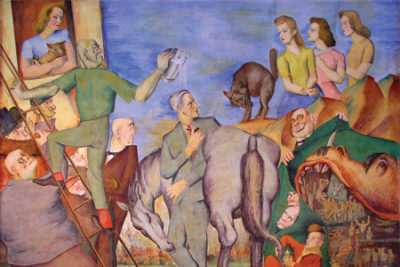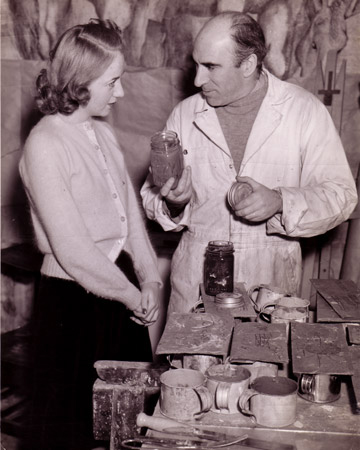The Luis Quintanilla Frescos in Haag Hall
Luis Quintanilla was a man of contrasts. He came from a long line of aristocrats, but he was a member of Spain’s Socialist Workers Party. He was a famous Spanish artist who led a battery of pro-Republic soldiers in defense of Madrid against the fascists.
In the late 1930s, General Francisco Franco’s oppressive regime forced Quintanilla to flee Spain for New York.
After completing a fresco-painting commission at the World’s Fair in New York, Quintanilla accepted an appointment as University of Kansas City’s first artist-in-residence and moved to Kansas City in 1940.
As part of the arrangement with UKC, which worked in cooperation with Rockefeller Foundation’s Committee for Displaced Scholars and Artists, Quintanilla agreed to paint a mural at the University.
The Spanish artist used UKC faculty, staff and students as models for his frescos, entitled, “Don Quixote in the Modern World,” a theme suggested by Dr. Clarence Decker, UKC President. Painted on the second floor of Haag Hall, the murals comprise six panels, covering 375 square feet of wall space.
Despite the fact that well-established American artists like Thomas Hart Benton and Grant Wood visited Quintanilla while he worked on the murals and praised the finished paintings, his work caused a controversy. Local response was voluble and varied: admiration, ridicule, puzzlement and shock.
In his book about the university, A Place of Light, Decker recalled an incident about one local resident who strongly disapproved of the Quintanilla’s murals:
“…Studying them one night after a lecture, a woman said, `Dr. Decker, I love the University, come here often for lectures and concerts, but how long do I have to put up with those monstrosities I encounter every time I pass through this lobby?’
“`I’ll tell you what we’ll do,’ [Decker] replied. `If you will give the University one million dollars, I’ll consider having them removed. If you give us two million dollars, I’ll mention the offer to the Board of Trustees. But if you give us three million dollars, I’ll demand that the Trustees order me to have them taken out and stored for a generation that will appreciate them.’
“Incredulous, the woman asked, `Do you mean that you really think they are worth three million dollars?’
“`I don’t know what their actual market value is today, [said Decker] but I am sure they will be priceless some future day’.”
Today, the Quintanilla murals are indeed one of the many priceless treasures at this 75-year-old institution.
In addition to their merits as works of art, Quintanilla’s murals in Haag Hall are all the more valuable because of their rarity. On a trip to Spain, Quintanilla learned that all of his art work, except for a few war drawings, had been destroyed either during the Civil War or afterwards by the Franco regime. The artist’s home and library were also destroyed, including his masterpiece, the eleven murals of the Pablo Iglesias Memorial in Madrid. UMKC’s six fresco panels of “Don Quixote in the Modern World” are one of few major, extant Quintanilla paintings.
To learn more about Luis Quintanilla visit http://www.lqart.org/.


